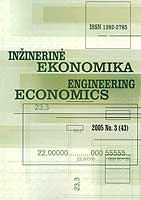Economic Management Aspects of Cooperatives
Economic Management Aspects of Cooperatives
Author(s): Julius Ramanauskas, Jadvyga RamanauskienėSubject(s): Economy
Published by: Kauno Technologijos Universitetas
Keywords: cooperative; share; differentiation; distribution; members’ turnover.
Summary/Abstract: It has been defined that not all aspects of classical theory of cooperatives can be applied to agriculture during the transitive period to the market economy. Some of them must be newly created. The most important conditions for successful establishment and development of cooperatives are economical management aspects: the accumulation of the primary stock capital (the size of the share), the rules of profit distribution, the right to vote, etc. One peculiarity of the agriculture of post-communist countries of this period that influences and hinders the activity of the cooperatives is the variety of farm sizes. In Lithuania thousands of small farms (with 2-3 ha of land) producing large part of the production exist beside the big farms (not numerous yet) and the agricultural communities with several hundred or even thousand ha of land, the great number of cattle, large green houses and manufacturing lots of produce. This stops the foundation and development of the cooperatives, because the small farmers without enough capital for the investments are unable to establish cooperatives. Big farmers and other agricultural subjects being more powerful economically and technically are not willing to cooperate with the small producers, because the cooperative regulations of Lithuania (like the rest countries) require that one member of the cooperative can have only one vote despite the size of his share. Besides the main part of the profit is distributed in accordance with the turnover, and only 10 per cent of the after-tax profit can be paid as dividends in accordance with the law (the maximum amount of the dividend is defined in the cooperative regulations).
Journal: Engineering Economics
- Issue Year: 2006
- Issue No: 4 (49)
- Page Range: 15-21
- Page Count: 7
- Language: English

